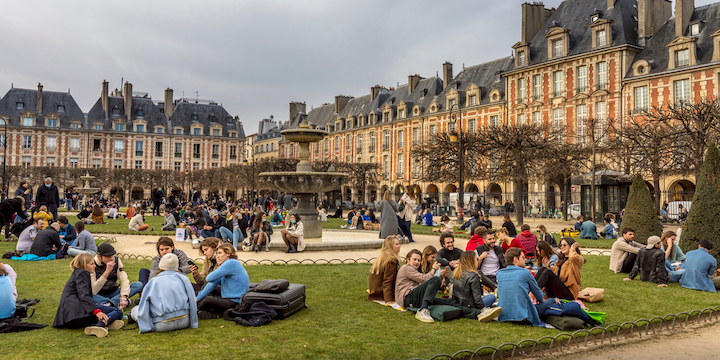Parks, gardens, quays … with the arrival of fine weather, the French are spending more and more time outdoors like last weekend. In Paris, the police have even evacuated the quays of the Seine on February 28, claiming a health risk.
But is taking a walk or having a picnic outside really a risk of contracting covid? For Pascal Crépey, professor-researcher in epidemiology and biostatistics at the School of Advanced Studies in Public Health (EHESP) of Rennes, the risk of contamination outside is “not bad“, but he is “limit“.
Contamination by postilions
Limited because we now know the three modes of transmission of covid: “aerosols, these particles that accumulate in the indoor air, exhaled postilions that contaminate nearby people within a meter and contaminated surfaces“.
But outdoors, in these three modes, only contamination by postilions is possible. “Aerosols cannot accumulate since by definition, the outdoor air is constantly renewed, and the virus does not survive for long on outdoor surfaces exposed to sunlight.“explains the specialist.
Also read: Home, restaurant, bar… what are the places most at risk of covid contamination?
The risk of groupings
And the risk is not zero, for example “in the event of a group of people, who stay nearby, without wearing a mask because they eat or drink together“observes Pascal Crépey. But this risk must be qualified:”there is, a priori, no risk of massive transmission“, unlike closed environments containing aerosols.
To his knowledge, there has in fact been no cluster – or foci of infection – observed outdoors. But it is not because we do not observe them that they do not exist. Because to detect these outbreaks, “it is necessary to identify the infected people, to question them, to establish links between them even if they do not know each other“Pascal Crépey list. The problem is the same as in public transport:”from a methodological point of view, it is more complicated to identify a cluster in these places than within a home, a company or a school“.
Only 5% of outdoor cases
What do scientific studies say? A study published on February 15, 2021 in the Journal of Infectious Disease by epidemiology researchers at the University of California at San Francisco (USA) reviewed published studies on viral contamination outdoors. Of the 12 studies included in this meta-analysis, five were specific to SARS-CoV-2.
And in total, less than 5% of cases were related to outdoor activities. For researchers, “the chances of transmission or super-contamination” thereby are “much weaker outside“.
18 times lower risk outdoors
Regarding clusters, these experts detail the case of a Chinese study published in Indoor Air which covers 318 sources of contamination. According to these data, only one transmission occurred outdoors out of a total of 7,324 reported cases.
They are also interested in a Japanese study not yet published but posted on the medRxiv prepublication site. It covers 11 clusters and concludes that the risks of contamination outdoors are 18.7 times lower than in an enclosed space.
Overall, all the studies analyzed go in this direction and only report a few cases of transmission outdoors, during a gathering in a park for example, or during a jog. In both of these cases, the mask was probably not worn. For Californian authors, this is when the outdoor gatherings take place “high density” with a “low mask wear“that transmission rates may increase.
Side by side rather than face to face
In conclusion, transmission outdoors is rarer than indoors but not impossible. In other words, for Pascal Crépey, “if you have to choose between an evening in an underground club in a poorly ventilated place and a picnic by the river, even if it means taking a risk, the picnic is preferable “.
And a few rules can help lower the risk even further. Wearing a mask during walks and choosing less frequented places are part of this. Settle “side by side rather than face to face“also during a picnic, to limit the exchange of postilions, advises Pascal Crépey.
And in the event of a picnic, the advice is the same as for a shared meal indoors, opening the windows less: individual portions and a single person in charge of the service.
 Cherry tomatoes contaminated with salmonella: 92 sick and 1 dead
Cherry tomatoes contaminated with salmonella: 92 sick and 1 dead  A better coaching method can make a person grow
A better coaching method can make a person grow  What is the method to prevent diabetes in children?
What is the method to prevent diabetes in children?  What are the effective factors in causing stomach ulcers?
What are the effective factors in causing stomach ulcers?  Why do embarrassing memories seem to appear at night?
Why do embarrassing memories seem to appear at night?  The amazing link between SARS-CoV-2 infection and newly started diabetes
The amazing link between SARS-CoV-2 infection and newly started diabetes  WHO says monkey pox is not a global emergency right now
WHO says monkey pox is not a global emergency right now  Single cell RNA sequencing uncovers new mechanisms of heart disease
Single cell RNA sequencing uncovers new mechanisms of heart disease  Hepatitis of unknown origin: 3 new deaths and 228 cases worldwide
Hepatitis of unknown origin: 3 new deaths and 228 cases worldwide 